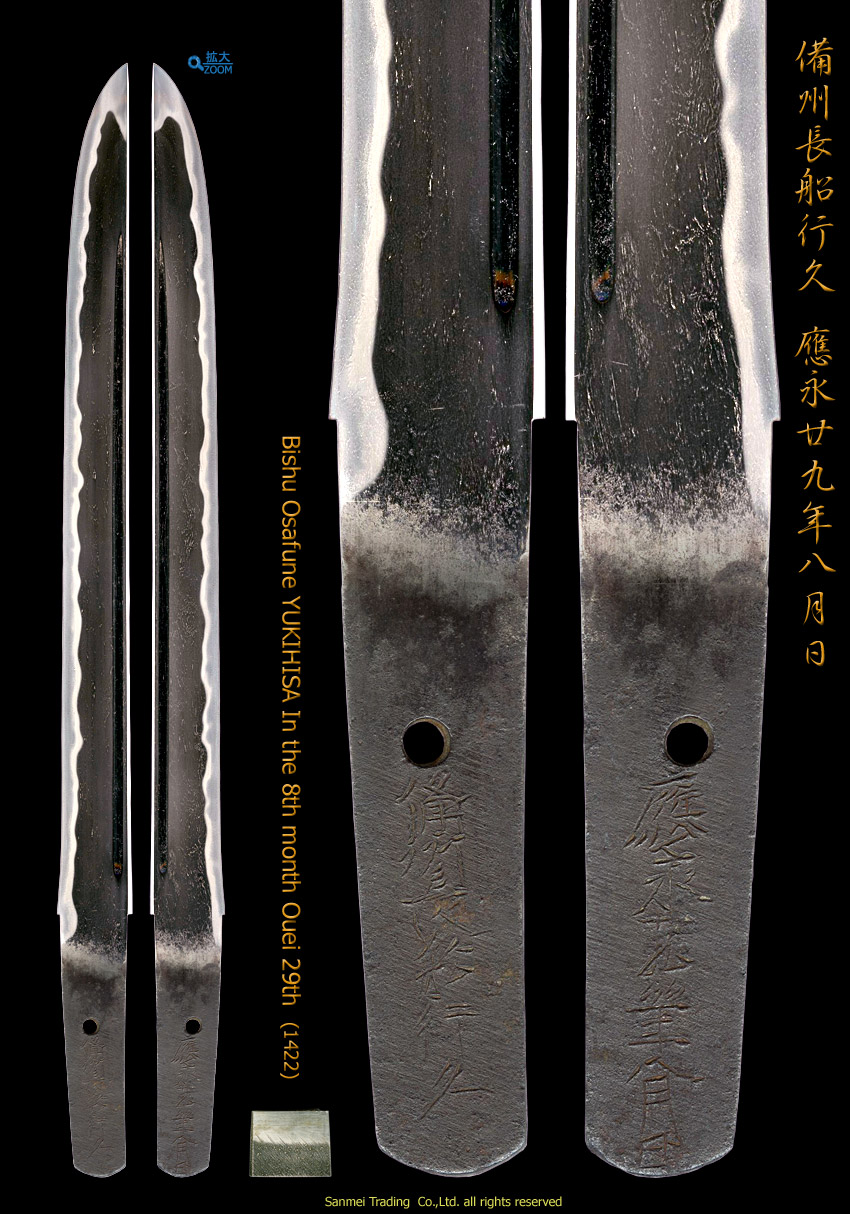In the 8th month Ouei 29th
Length of cutting edge 30.6cm Curvature 0.1cm Width of base 26.7mm Thickness of base 5.5mm
Forging pattern (kitae hada) : Kitaehada is conspicuous Itame mixing with large Mokume-hada partially. The surface is covered in Ji-nie (hard metal granules over the surface) with Chikei (darkish Nie lines) activity. Speckled sparkling reflection so called Midare-Utsuri clearly appears entirely from base to tip on Hiraji.
Tempering pattern (hamon) : Quenching line is covered with a bit on tighter side of Nioi where uniform fine Ko-Nie hard metal granules is perceived along temper, starting with GunomeYakidashi on base, Notare undulating wave - mixture of small Gunome zigzag and Clove outline that goes down a gentle hill. The interior of temper where is filled with deep frog granules of Nioi.
Temper of tip (boshi) : Temper of tip is a bit on stronger side of Ko-Nie that forms irregular pattern harshly with "Hakikake" brush up indication then small circle turns back in front and the other side forms large circle turns back.
Tang (Nakago) : Nakago is relatively short. Double bevelled Kurijiri bottom shape. Nakago is UBU no curve, unaltered. Greatly slanting left Ō-sujikai file marks. One retaining hole of Mekugi-ana. The clear signature is inscribed in front 6 long character that starts with the place of work Bishu Osafune 備州長船 and the smith name YUKIHISA 行久. The other side is chiselled with the date of year In the 8th month, Ouei 29th 應永廿九年八月日.
The founder of YUKIHISA 行久 in Osafune appeared on about Ouan era (1358-) and extant works ranges down to Keikyo 3 (1431) presumably in two or three generations.
The subject YUKIHISA 行久 in Ouei era is said a son of HIDEMITSU 秀光 or a great-great-grandson of MOTOMITSU 基光 who belongs to KANEMITSU 兼光 school.
An Ouei Bizen 應永備前 is the alias that many of the swordsmith in Bizen Osafune during Ouei era (1394-1427) marked the Imperial era name Ouei 應永 date of year.
After the Northern and Southern Dynasties 60 years disturbance period, Samurai dandyism lost in power and the restoration of ancient works came into fashion.
We observe that wide mihaba of the previous period gradually disappears under peace and quiet of daily life in early Muromachi period.
Tanto or Hira-zukuri style wakizashi became longer and bigger in general and hamon forms gentle, antique and elegant in accordance with reactionism at the time.
The subject classical tanto is the sublime work by the 2nd generation YUKIHISA 行久, a son of HIDEMITSU 秀光 in Osafune. Nakago holds splendid taste of patina that remains impressively clear chisel of inscriptions with the date of year.
This prominent tanto is admired for the entire original shape and also an excellent quality of the legitimate Bizen Osafune technique nearly the passage of 600 years ago.
Single layer silver Habaki collar, preserved in a Shira-saya plain wood mounting.
Fresh polish/Condition scale: excellent - very good (using a scale of mint-excellent-very good-good-fair-poor)
reference data : Honma


